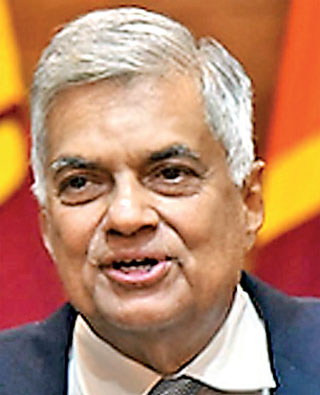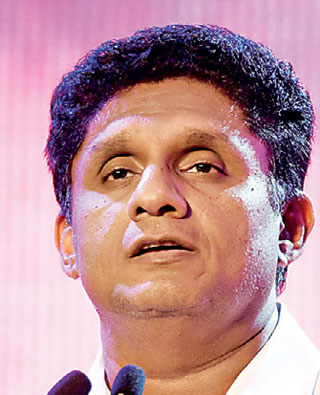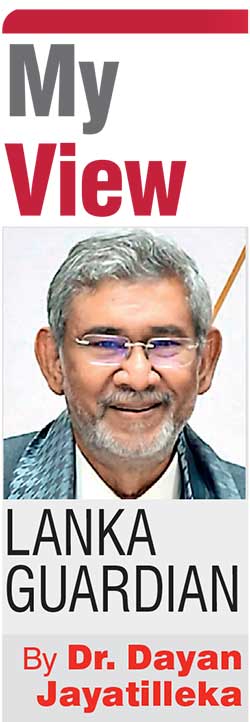Sunday Jan 18, 2026
Sunday Jan 18, 2026
Thursday, 29 December 2022 00:30 - - {{hitsCtrl.values.hits}}

President Ranil Wickremesinghe

Dullas Alahapperuma

Hirunika Premachandra

M.A. Sumanthiran

R. Sampanthan

Sajith Premadasa
|

The modern American colloquialism “screw the pooch” dates back to NASA and the US space program. It was popularised by the legendary founder of ‘new journalism’ and author Tom Wolfe in his 1979 book on the Mercury program, The Right Stuff, turned into a movie in 1983. In it, astronaut Gus Gifford, played by Denis Quaid warns “don’t screw the pooch”. “Screw the pooch” means an egregious blunder; the act of committing an egregious blunder. It means to “f**k up”. A cruder original version dates back to the US Navy in World War II and had been subsequently sanitised by a disc jockey.
If President Ranil Wickremesinghe’s Advisor (until recently) Prof. Ashu Marasinghe actually did what it looked like he was doing when almost all of us saw almost all of him on primetime TV news last week, he literally and metaphorically did what the NASA guys said you never should. If not, then why resign with such alacrity, why the hangdog expression walking into the CID, and what could be a credible counter-explanation for what we saw on TV?
The irascible Field Marshal Sarath Fonseka, SJB Chairperson, expressed the decided view that anyone engaged in the sexual abuse of animals should be punished by letting a rabid dog nibble on him.
The irrepressible, impassioned Hirunika Premachandra, firebrand leader of the Samagi Vanitha Balavegaya the women’s organisation of the main Opposition, the SJB, went on from the stunning indictment of Ashu Marasinghe to the (hitherto uncontradicted) allegation of a bed ordered for the President’s office room in Parliament. The news snippet concluded with her damning accusation of sexual favouritism as factor in politics and decision-making allegedly at apex levels.
UNP’s fate
Dullas Alahapperuma, the respected leader of the FPC said the bestial episode badly damaged the Sri Lankan brand and was a loud wake-up call about the degeneration of contemporary Sri Lankan society and politics.
What few readers would know is that at the General Election of 1956 which swept away a government and displaced an elite already hit hard by the working people’s uprising — ‘Hartal’ – of August 1953, a main charge was moral decrepitude on the part of the UNP ruling elite. This was most effectively evoked by the famous ‘Mara Yuddha’ cartoon.
The celebrity as sick puppy scandal shows the ethos of the ruling elite as one of utter decadence, reminiscent of the fall of Rome. That’s as far as the UNP goes. The widespread public perception of its partner the ruling SLPP (or its leading oligarchy) as purloining public funds and looting foreign loans, completes the picture of irredeemable corruption and decadence.
One wonders what those who urge that the SJB reverse its supposed ‘original sin’ of splitting from the UNP in 2020 and re-unite with the Ranil-led UNP, and that the reunified UNP and JVP should re-enter a functional relationship as in 2015-2019, think about the correctness and chances of their slogan, now that social media is widely circulating a graphic of the UNP banner with the elephant substituted by a household pet. One also wonders what the JVP thinks of the idea of a functional relationship with the UNP today.
The SJB-UNP re-convergence suggestion is wrong-headed on several counts:
1. The UNP is pretty much extinct. With a strong dynamic of anti-establishment change nationally and globally, why should the growing SJB be tainted by association with it, thereby providing ammunition for the JVP-JJB?
2. Ranil’s neoliberal UNP does not represent the liberal-conservative UNP tradition and has not done so for a quarter-century, which is why the member of the SJB most persecuted by Ranil while in the UNP, and the most leftwing front-bencher of the SJB today, is the second-generation ‘thoroughbred’ UNPer, Imthiaz Bakeer Markar.
3. A more progressive project was long germinating within the UNP, beginning with the Puravesi Peramuna of Ranasinghe Premadasa 50 years back and extending to his readiness to run on an independent platform in 1988 if deprived of the UNP nomination. Premadasa’s discourse and developmental policy paradigm exemplified that non-elitist transformational-developmentalist project. The Sajith Premadasa-led SJB is partially and potentially its actualisation, which is especially timely given the decay of the UNP and SLPP, the collapse of the established political Centre, and the challenge mounted by the JVP.
4. The convergence necessary today is not one of the SJB-UNP, i.e., the Right or Centre-Right, but of the SJB-FPC-SLFP i.e., a renovated, moderate-progressive Centre.
Ranil’s role
There is no scenario in which President Ranil Wickremesinghe wins an election; not even if the entire Tamil vote comes his way. As to outcomes, there are only two probable scenarios.
In the first scenario, Ranil accepts local government elections on schedule, takes the hit, leverages it to dissolve parliament in March 2023, uses the ‘Gaullist-Bonapartist’ presidency for multipolar balancing which it is capable of, and manages a soft landing or exit with President D.B. Wijetunga as role-model.
The second scenario begins with blocking the local government election process in January 2023 thereby moving from ‘thin ice’ legitimacy to zero-legitimacy, and ends (at best) with the evacuation of the non-elected ruler by the US/India/China.
For Ranil, the best possible outcome means a safe landing, i.e., managing his political exit and going ‘head first’. If you think my forecast extreme, please read the title of one of my Daily FT columns this volatile, unpredictable year, 2022. It was called ‘Rage against the regime: Why President GR should resign’. This is how that article ended:
“…If MR cares for the people, his brothers, his family, and the way his story will be written in history, he should tell his younger brother Gotabaya who stood on his shoulders to become President and is still shielded by him, that for the sake of the family’s name, for the sake of the memories of their father, uncle and cousins, for the political future of any Rajapaksa at any time in the next decades, he must step down immediately from the Presidency and retire from politics. It would be the decent and wise thing to do. Someday the people may forgive him. If ex-President Mahinda Rajapaksa does not do this and if President Gotabaya Rajapaksa does not listen, this will not end well, but it will end sooner rather than later.”
(Rage against the regime: Why President GR should resign | Daily FT)
Most relevant is the date of publication: 17 March 2022. It was well before the inauguration of the Aragalaya at Galle Face Green on 3 April and a fortnight before the demonstration outside his Mirihana residence on 31 March, when I urged Gotabaya to evacuate.
SLPP screwed the pooch too
The ruling SLPP run by the Rajapaksas sure “screwed the pooch” when it had a clear option to do otherwise. The SLFP and its derivative the SLPP have ruled the country i.e., been elected to the presidency, for 28 years. This was after 17 years in the cold as a defeated party. What was the secret of its recovery and longevity in office?
It was to re-profile by changing its leadership and thereby the target profile it presented. Thus, Madam Sirimavo Bandaranaike was replaced by Chandrika Kumaratunga, Chandrika by Mahinda Rajapaksa, Mahinda by Maithripala Sirisena, and Maithripala by Gotabaya Rajapaksa.
The biggest chance—and test—came this year with the Aragalaya. Gotabaya resigned, and the Rajapaksas retreated, installing a new leader, but completely violated the successful formula of decades. The SLPP had within its ranks a perfect successor, once their top ideologue and among the very few whose house was untouched during the anti-government rioting of 9 May. That was Dullas Alahapperuma who could as a leader have reprofiled the SLPP as the parent SLFP had done so often; changed its ideology, reformed it, restored some credibility by promoting respected dissidents (e.g., Prof. Charitha Herath) and re-incorporating the SLFP.
Given that Sajith Premadasa had withdrawn his candidacy and pledged his support, a Dullas Alahapperuma interim/transitional presidency could have garnered the broadest all-parties support to manage the economic crisis.
The Rajapaksas spurned the Dullas option and condemned the SLPP to UNPesque electoral elimination. They didn’t do so because Ranil Wickremesinghe alone could address the international community. The Dullas group had as co-leader, Prof. G.L. Peiris, the SLPP chairman and former foreign minister, who could have done the job.
The Rajapaksas opted against Dullas and picked Ranil precisely because they knew Dullas, if even partially successful, would have been entrenched as SLPP leader and thereby delayed/deferred Namal Rajapaksa’s assumption of the party’s leadership. Now the SLPP faces the hopeless prospect of elections carrying the deadweight of both the Rajapaksas and Ranil Wickremesinghe on its back.
Roadblocks to ethnic reforms
Gamini Samaranayake, ex-April 1971 rebel and political prisoner, professor of political science, former Chairman-University Grants Commission, and former ambassador to the Philippines, used to caution his gentrified academic colleagues who had joined the amply-funded peace bandwagon of President Chandrika Bandaranaike Kumaratunga, Prime Minister Wickremesinghe and Norway that “you cannot reconcile with the North while alienating the South; you cannot make peace in the North while risking conflict in the South.”
A positive outcome from the roundtable process chaired by President Ranil Wickremesinghe requires an audit of past efforts and autopsy of past failures.
The negotiations of the All-Parties Conference of 1989-1991 chaired by President Premadasa were about to reach fruition but the jigsaw lacked an essential piece for completion. Therefore, Premadasa told M.H.M. Ashraff of the SLMC and Suresh Premachandran of the EPRLF to agree on a formula for Tamil-Muslim power-sharing in the Eastern Province. “Leave the Sinhalese to me, I’ll persuade them,” he said. At the last moment, Suresh Premachandran reneged on the agreement arrived at with Ashraff.
President Premadasa then appointed the Mangala Moonesinghe Parliamentary Select Committee (1991-1992) which recommended the trade-off of the merger of the North and East in exchange for Indian-model quasi-federalism. It was rejected by the Tamil parties except for a single outlier.
The 1995 and 1997 political packages of President Chandrika Kumaratunga for the reconstitution of the Sri Lankan state as a non-unitary ‘union of regions’ were shot down by a revived Sinhala majoritarian populism which had been defeated as a phenomenon by CBK’s 1994 electoral triumph.
A more acceptable version negotiated by Prof. G.L. Peiris and Karu Jayasuriya in the form of the August 2000 constitutional draft was not supported at the crucial vote by the major Tamil formation led by Sampanthan and set on fire in parliament by the UNP led and visibly egged-on by Ranil Wickremesinghe.
The Post-Tsunami mechanism (PTOMS) of President Kumaratunga was challenged legally by the JVP and shot down by the Supreme Court. It also violated US laws which prohibited funding any structure dominated by a designated terrorist organisation.
During the first term of the Mahinda Rajapaksa presidency, the enlightened recommendations on devolution of the subcommittee of the Tissa Vitharana Committee headed by Dr. Rohan Perera were stillborn because of objections from the JVP represented by Tilvin Silva. MR couldn’t afford the defection of the JVP given the parliamentary arithmetic. His compensatory tilt to retain his numbers strengthened the anti-devolution lobby in the ruling coalition.
Prime Minister Ranil Wickremesinghe’s and the TNA’s M.A. Sumanthiran’s constitutional draft of 2015-2019 and their accountability mechanism presented in Geneva in 2015 had singularly spectacular results. The President and the PM, and the SLFP and UNP were driven apart. The bulk of the SLFP moved back to Mahinda Rajapaksa. The UNP lost so much of its Sinhala vote base by the local government election of February 2018 that most of its members and MPs felt they had to contest the Presidential election (2019) under a candidate other than – and different from—Ranil, and form a new party and re-brand under that candidate (who had polled 42%) to survive the 2020 General election.
Realist reform recipe
All these systemic or structural ethnic reform attempts failed under far more favourable circumstances than today: the pressure of a war, military defeats and a strong Tamil challenge; popularly elected presidents; a bipartisan administration; a relatively prosperous economy.
Autonomy and accountability projects that failed under favourable circumstances can prove deadly if tried under far more unfavourable ones such as an unelected president who has no viable political party to call his own, and an economy that has tanked.
The starting point has to be that which has survived—if only barely—the travails of the past decades, including a Southern civil war in which it was an issue. This is the 13th amendment to the Constitution.
Here too, caution is in order. The Indo-Lanka accord and its product the 13th amendment fuelled a powerful civil war which it would not have, had the parliament that passed it had legitimacy in the eyes of the public. It did not, because the UNP of President Jayewardene had frozen the 1977 parliament in place by postponing for six years the holding of a general election scheduled for early 1983. As this column has repeatedly argued, the political status quo today has an even greater crisis of legitimacy than in the 1980s, because at that time the incumbent was popularly elected, unlike today.
Any attempt to stretch the 13th amendment will only cause snap back. References to federalism and self-determination, be the latter external or internal, only make it more difficult to implement the 13th amendment itself because 13A would be perceived as merely a stepping stone.
My 5-point Realist solution follows:
I. The discussion has to be capped. Only if it is agreed that the 13th amendment will be a ‘final status agreement’ or that there will be a 15-year moratorium on further demands will it be possible to fully implement it without a polarising set of challenges starting with the Supreme Court arena.
II.Controversial provisions regarding Police powers and land require a graduated, incremental, sequential approach to implementation, with India kept in the loop. III.
III.The discussion must zero-in on adjustments that all parties can agree upon so as to enable the Provincial Councils to function, i.e., deliver, more fully and effectively.
IV.On accountability, the superlative report of Sir Desmond de Silva QC (a.k.a. the Paranagama Report) can be implemented in its purely domestic variant (of several options provided). However, any move on wartime accountability could cause a military backlash and should not be implemented this side of parliamentary and presidential elections.
V. Emphasis should shift to anti-discrimination and equality of citizenship. The focus should be the UN’s blueprint to combat racism, racial discrimination, xenophobia and related intolerance, the Durban Declaration and Program of Action (DDPA). Having been elected Chairperson-Rapporteur of the UNHRC’s Working Group on the Effective Implementation of its Programme of Action (2008-2009), I am certain that thanks to the Aragalaya’s enlightened social consciousness, all parties would agree to eliminate discrimination and ensure actual equality of rights and thereby of citizenship. That could be a fitting salute to the Aragalaya which overthrew the Gotabaya presidency, thought to incarnate the irreversible victory of hegemonistic Sinhala chauvinism.